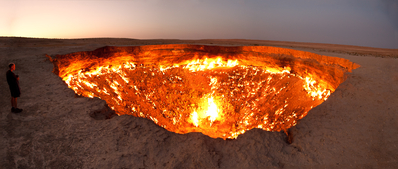Gateway to Hell
I was putting together our family pub quiz this week and stumbled on a question that completely blew my mind. It was about this place in Turkmenistan officially called the Darvaza gas crater, but it’s also known as the "Gateway to Hell." The name alone had me hooked, and once I started reading about it, I realised it’s one of those insane real-world stories that perfectly captures the waste and unintended consequences of our fossil fuel age.
Back in 1971, a team of Soviet geologists were drilling out in the Karakum Desert, pretty much in the middle of nowhere. They were looking for natural gas, and they thought they’d hit a decent pocket of it. Turns out, they’d actually drilled right into a massive underground cavern that was just full of the stuff. The ground gave way, swallowing their drilling rig and leaving behind a gigantic crater. To make matters worse, it immediately started spewing methane gas, a huge problem for the environment and for anyone living nearby.
Faced with this uncontrollable leak, the engineers made a call that probably seemed logical at the time: they decided to set it on fire. Their thinking was that it would burn off the dangerous gas in a few weeks and then fizzle out. The only problem? They had no idea how much fuel was down there. That was over 50 years ago, and the crater is still burning today. It’s a literal pit of fire that’s been roaring non-stop since the Nixon administration, which is just wild to think about.
When you look at it from an energy and climate perspective, the whole thing is a total nightmare. Before they lit it, the crater was just venting pure methane directly into the air. Since methane is an incredibly powerful greenhouse gas (way more potent than CO2 in the short term) burning it was actually the lesser of two evils. But the lesser evil is still pretty evil. They estimate this thing burns through about 20 billion cubic feet of natural gas every single year. That translates to roughly 300,000 tons of CO2 emissions annually, which is comparable to the yearly output of an entire small country.
It’s become a weird tourist attraction over the years, which adds another layer of irony. The government has occasionally talked about putting it out, and a few years back the president even made a big show of saying it needed to be extinguished to stop the environmental damage and save the lost resource. But snuffing out a fire that’s been fed by a bottomless gas supply for five decades is way easier said than done. They’ve looked into everything from dumping massive amounts of sand on it to pumping in inert gases, but so far, nothing’s worked. The Gateway to Hell just keeps on burning.
For a community like ours that’s focused on clean energy and smarter solutions, this whole saga feels like a perfect cautionary tale. It’s a stark reminder of the "drill now, ask questions later" mindset and a visceral example of how much energy we can literally throw away without a second thought. While we’re here talking about heat pumps, optimising solar farms and building better batteries, there’s a hole in the desert that’s been burning away for half a century. Madness!
Get a copy of The Ultimate Guide to Heat Pumps
Subscribe and follow our YouTube channel!
Man interferes with nature at its’ peril.😳 Toodles.
Toodles, heats his home with cold draughts and cooks food with magnets.
Or….. how about dumping a few million ICE vehicles into it to smother it? Toodles.
Toodles, heats his home with cold draughts and cooks food with magnets.
Posted by: @toodlesOr….. how about dumping a few million ICE vehicles into it to smother it? Toodles.
Or EVs to burn it out more quickly?
Retrofitted 11.2kw Mitsubishi Ecodan to new radiators commissioned November 2021.
14 x 500w Monocrystalline solar panels.
2 ESS Smile G3 10.1 batteries.
ESS Smile G3 5kw inverter.
Retrofitted 11.2kw Mitsubishi Ecodan to new radiators commissioned November 2021.
14 x 500w Monocrystalline solar panels.
2 ESS Smile G3 10.1 batteries.
ESS Smile G3 5kw inverter.
- 26 Forums
- 2,342 Topics
- 53 K Posts
- 211 Online
- 6,000 Members
Join Us!
Worth Watching
Latest Posts
-
RE: Help me keep the faith with my air source heat pump installation
@simonf thats interesting as I’ve noticed my flow and r...
By AdamK , 36 minutes ago
-

RE: LiFePO4 lithium battery fires and explosions
@batpred — your latest post here has more than a bit of...
By cathodeRay , 45 minutes ago
-

RE: MELcloud scheduling misbehaviour
No, it gets to set temperature easily even during perio...
By Abernyte , 1 hour ago
-

RE: Setback savings - fact or fiction?
@robs — is there anything weird in your post or footer/...
By cathodeRay , 1 hour ago
-
RE: Free Ecoheat Heat Pump Install
Sorry hit 'add reply' too early, this forum layout will...
By Deltona , 2 hours ago
-
RE: Poll for Time of Use, tariffs, technology
@batpred Fair enough, if the usage of these materials i...
By Papahuhu , 2 hours ago
-
And arguably even more important, sodium will be hopefu...
By Batpred , 6 hours ago
-
RE: A Smarter Smart Controller from Homely?
I've been thinking of emailing Homely to ask for a few ...
By JohnnyB , 18 hours ago
-
Max output of Heat pump (Daikin 4Kw EDLA04)
Hello, I am a bit puzzled that according to pcdb tes...
By GeorgeA , 18 hours ago
-

In that case, @technogeek, I’d sign up for the free sol...
By Majordennisbloodnok , 19 hours ago
-

RE: Has Anyone Else Noticed a Decline in Tradesmanship?
@cathoderay Hence my rider about ‘all else being equal’...
By Toodles , 20 hours ago
-

RE: Heat Pump Performance Analysis Web App using Modbus Data
@redzer_irl — all my heat pump data is in csv files, me...
By cathodeRay , 20 hours ago
-

That’s not a problem. If you can hit the main landing p...
By Majordennisbloodnok , 20 hours ago
-

RE: Configuration issues with 10kW Midea R32 heat pump
@benson I believe there are quite a few of these instal...
By Toodles , 20 hours ago
-
RE: 10kw heat pump run in 24*7 data?
I would say you most likely do need 10kW. My gas consu...
By JamesPa , 21 hours ago
-
RE: Mitsubishi Ecodan 11kw Defrosting Issue.
@thundermink I managed to find the fault. I did it a lo...
By meehow , 21 hours ago
-
RE: Here is my heat pump installation with questionable COP in Italy
Well in Italy there is nothing controlling the quality ...
By materox345 , 23 hours ago
-

RE: What a Bad Heat Pump Installation Looks Like
@editor The trick to an inside unit installation is to ...
By MikeFl , 2 days ago






